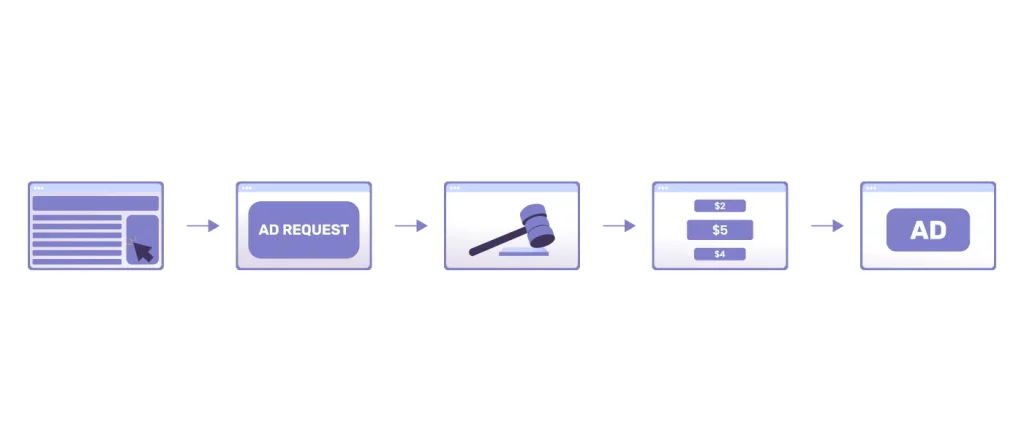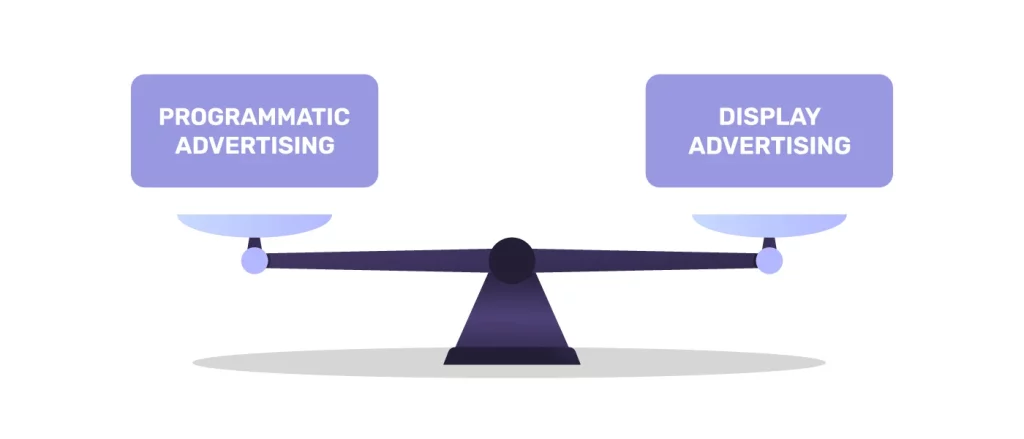What Is Programmatic Display? How It Works and Its Benefits
Let’s face it: businesses always search for more innovative, efficient ways to connect with their audience. With its manual setup and high costs, traditional display advertising is becoming less effective. That’s where programmatic display advertising comes in. It’s an automated, data-driven way to buy and sell digital ad space. It works faster, costs less, and precisely reaches the right audience.
But what exactly is programmatic display advertising? How does it work? And why should you care? In this article, we’ll break it down in simple terms, compare it to traditional display ads, and share practical tips to help you make the most of it.
Table of Contents
What Is Programmatic Display Advertising?
Programmatic display advertising is a more innovative way to buy digital ad space. Instead of manual negotiations, it uses real-time algorithms to purchase ads automatically. This method relies on data like user behavior, interests, and demographics to show ads to the right people at the right time, on the right platform, whether it’s a website, an app, or another digital space.
Unlike traditional display ads, which require hands-on setup and direct deals, programmatic advertising simplifies the process. It boosts efficiency, improves targeting, and allows real-time adjustments to keep ads relevant and cost-effective.
How Programmatic Display Advertising Works

Programmatic advertising relies on tools like Data Management Platforms (DMPs), Demand-Side Platforms (DSPs), and Supply-Side Platforms (SSPs). DMPs organize audience data, DSPs help advertisers buy ad space by automating the process using Real-Time Bidding (RTB), and SSPs allow publishers to automatically manage and sell their ad inventory to the highest bidder.
Here’s how it works:
- A user visits a website with available ad space. The website sends an ad request to an ad exchange.
- Advertisers bid for that space in a real-time auction based on user data such as demographics, interests, and browsing behavior.
- The highest bid wins, and the ad appears instantly on the user’s screen.
Programmatic Direct is another option within programmatic advertising, where advertisers purchase ad space directly from publishers, bypassing auctions for guaranteed impressions at a fixed cost. This approach offers more control and avoids the competition and unpredictability of RTB.
Moreover, many advertisers use platforms like the Programmatic Open Exchange to connect with high-quality inventory through RTB.
The Benefits of Programmatic Display Advertising
Programmatic display advertising offers several advantages over traditional methods. Here are the key benefits:
| Benefit | Description |
|---|---|
| Enhanced Targeting | Ads are powered by data, allowing advertisers to target users based on behavior, interests, demographics, and more. This results in more relevant, personalized ads. |
| Cost-Effectiveness | Advertisers only pay for ads shown to the right users, reducing wasted ad spending. This makes it more affordable compared to traditional display ads. |
| Increased Efficiency | Automation reduces manual work, saving time and resources. Campaigns can be adjusted in real-time based on performance, optimizing results. |
| Better ROI | With more precise targeting and real-time optimization, programmatic ads typically deliver higher ROI. |
| Scalability | Campaigns can quickly be scaled across multiple AdTech platforms and devices, reaching a broad audience without significant resource expansion. |
It is predicted that by 2025 and 2026, advertisers will move $9.56 billion from traditional ads to programmatic advertising. This shift shows that more businesses prefer automated, data-driven ads because they are more efficient, cost-effective, and better at reaching the right audience.
Types of Programmatic Advertising
There are 4 programmatic advertising types, each designed to meet specific goals:
- Real-Time Bidding (RTB): An open auction where ad impressions are bought and sold instantly. Advertisers bid in real-time, and the highest bidder wins, ensuring that ads reach the right audience efficiently.
- Private Marketplaces (PMP): Invite-only auctions where premium publishers offer ad space to select advertisers. This method provides more control, exclusivity, and transparency than opening auctions.
- Preferred Deals (PD): One-on-one agreements between publishers and advertisers. Advertisers get the first look at inventory at a fixed CPM (Cost per Thousand Impressions) before the ad space becomes available in an open auction.
- Programmatic Guaranteed (PG): A direct ad inventory purchase without an auction. This approach involves a fixed-price agreement between an advertiser and a publisher, ensuring premium placements and guaranteed impressions.
Programmatic Ads vs. Display Ads

Though programmatic display advertising is a form of display advertising, they differ significantly:
| Traditional Display Ads | Programmatic Display Ads |
|---|---|
| Bought through direct deals with publishers at fixed rates. | Purchased via automated, real-time auctions using data for targeting. |
| A slower process that requires manual negotiation. | Fast, automated, and optimized based on data. |
| Less precise targeting. | Precise targeting based on user behavior, location, and demographics. |
Thus, we conclude that programmatic ads offer more precision, flexibility, and efficiency than traditional display ads.
Best Practices for a Successful Programmatic Display Campaign
1. Use Data to Target the Right Audience
Programmatic advertising thrives on data. Use audience insights to target users based on their behaviors, interests, location, and demographics. The more detailed your data, the more precise your targeting will be. This means your ads will reach the people most likely to engage with your brand, reducing wasted ad spend.
2. Continuously Optimize Your Campaigns
Don’t just set up your campaign and forget about it. Monitor performance in real-time and adjust as needed. If a particular audience segment isn’t responding well, tweak your targeting. If a specific ad creative is underperforming, test a new design. Adjust bidding strategies based on performance to ensure you get the best return on investment (ROI).
3. Prioritize High-Quality Ad Creatives
Even with the most advanced targeting, your ads won’t be effective if they aren’t visually appealing or compelling. Ensure your ad designs are eye-catching, your messaging is clear, and your branding is consistent. A well-designed ad can grab attention and encourage users to click.
4. Define Clear Goals from the Start
Before launching a campaign, determine your primary objectives. Are you trying to increase brand awareness, drive website traffic, generate leads, or boost sales? Clear goals will help you measure success and make informed adjustments throughout the campaign.
5. Test, Learn, and Improve
Programmatic advertising is all about experimentation. Run A/B tests with different ad creatives, formats, and bidding strategies to see what resonates best with your audience. Try headlines, colors, images, and call-to-action buttons to find the winning combination. Regular testing will help you fine-tune your strategy and improve performance over time.
By following these best practices, you can ensure that your programmatic advertising campaigns are more effective and reach the right audience with the right message at the right time.
Common Programmatic Display Challenges and How to Overcome Them
1. Ad Fraud
Ad fraud, including bot traffic and invalid clicks, can eat up advertising budgets. Combat this by working with trusted platforms and implementing fraud prevention tools.
2. Data Privacy Concerns
Data privacy is crucial under regulations like GDPR and CCPA. Advertisers must comply with these laws and ensure transparency in their data practices.
3. Complexity of Platforms
The sheer number of programmatic platforms can be overwhelming. To navigate these complexities, consider working with experienced programmatic agencies or trusted ad platforms.
Look at the best programmatic advertising platforms to get started and discover useful insights.
FAQ
Yes! This is retargeting, where ads “follow” users based on their previous interactions with a website. It helps remind potential customers about products or services they show interest in.
Nope! Even small businesses can use programmatic ads with smaller budgets, targeting local audiences and optimizing spending with real-time bidding.
Almost! Using AI and machine learning, programmatic platforms analyze browsing behavior to predict what products or services might interest you.
No! While it started with display ads (banner ads), programmatic advertising has expanded to include video ads, audio ads, native ads, digital out-of-home (DOOH), and even connected TV (CTV) ads. This allows advertisers to reach users across multiple channels with a unified strategy.
Final Thoughts
Programmatic display advertising is changing the way businesses run digital ads. It’s faster, wiser, and more cost-effective than traditional display advertising because it automates ad buying, improves targeting, and boosts ROI. Whether a small business or a big brand, programmatic ads help you reach the right people at the right time without wasting money.
We hope this article clarifies programmatic display and how to get the best results. Focus on using data wisely, testing strategies, and creating eye-catching ads. As more companies switch to programmatic, staying up to date will help you stay ahead in the digital world.